Thrust area of Healthcare, Energy and Materials Characterization is highlighted in the 9th issue of Advanced Materials Letters, September 2020
Advanced Materials Letters (AML) released its 9th issue, September 2020, which focused on “Materials Characterization” based on energy and healthcare research procedures. In the recent times, thrust areas related to state-of-art characterization in chemical, energy and healthcare research has been one of the major attractions in the materials science and technology. The present issue has nine articles focused on energy efficiency, nonmaterial’s characterization along with healthcare perspectives for the advancement of materials towards subsidiary benefits. International Association of Advanced Materials (IAAM) publishes research articles in its official journal, AML, which has excellent representation of materials research for worldwide scientific community.
The present issue highlights the consequences for COVID-19 vaccine development through mechanistic approach for better understanding of healthcare perspective. The contribution of nanotechnology is enormous and discussed in this issue for improving animal and human healthcare. Study of optical characterization of double perovskite and article of solar cell characteristic study highlights the importance of energy research. Study on behavior of pultruded GFRP members is another work presented briefly in this issue. The photocatalytic-biocatalytic attached system and molecular dynamics and FEM modeling of composites are the important materials science research discussed in the present issue. In the last, articles covering functionalized hydrophilic superparamagnetic iron oxide nanoparticles and green nickel oxide nanomaterial synthesis using plant leaf extract was discussed.
The importance of September issue of Advanced Materials Letters increased due to hard work and timely contribution of materials professionals, reviewers’ comments along with IAAM team members efforts in compiling the articles in the journal. The materials articles cover sufficient source of information for recent progress and prospects for healthcare, energy field. IAAM involvement in worldwide networking to establish advanced materials field as leading scientific field for sustainable and green world becomes reality at coming days due to its not-for-profit, Diamond Open Access (DOA) journals structure.
About Cover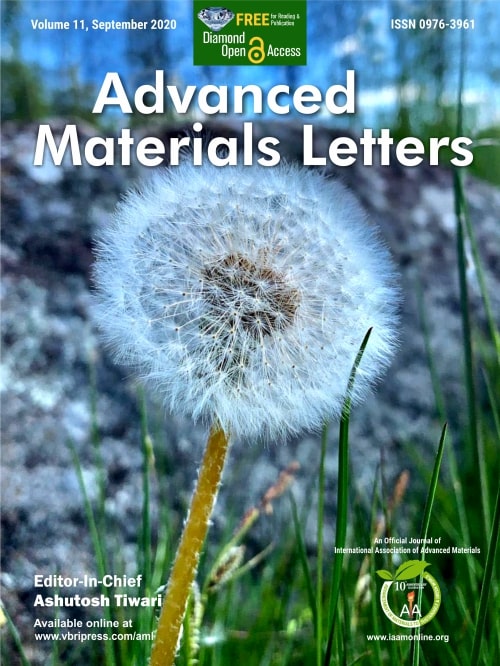
Green and sustainable development highlights the improvement of social, economic, and environmental assets to meet the needs of present and future generations. The entire world is working on designing projects having ecological sustainability to boost the lower-carbon future for the next generation. The cover photo of the current issue of Advanced Materials Letters is dedicated to the International Association of Advanced Materials’ agenda of the next decade - "Advancement of Materials to Green and Sustainable World".
Article 1: COVID-19: A Mechanistic Approach to Understand the Detrimental Consequences for Vaccine Development and Perspectives
The first article of the issue solely talks about the mechanistic approach to understanding the characteristic properties of the deadliest virus (COVID-19). This article is authored by Chander Amgoth, et al. from Zhejiang University, China and Tel Aviv University, Israel. Here, the author described that the nano-sized (160-200 nm, in diameter) virus along with the spikes (length ~10 nm) play crucial role in infection. Mutations lead to an increase in population density and glycoprotein of spike spindles fuses the surface of lung cells through the binding affinity. Inflammation caused because of the replicated complex of virus blocks the passage of gases O2, CO2 which lead to severe cough and respiratory problems. This unusual phenomenon of pneumonia leads to death. Further, massive computing is needed to understand the exact detrimental consequences of COVID-19 followed by the drug and vaccine development.
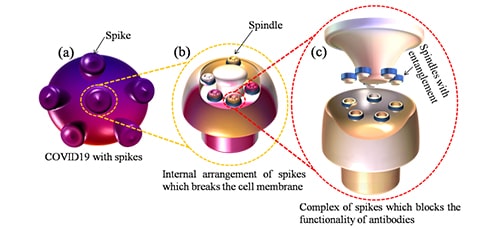
Citation of the article: Adv. Mater. Lett., 2020, 11(9), 20091551. [Download Full Text in PDF]
Article 2: Contribution of Nanotechnology in Animal and Human Health Care
The second article of the issue is authored by Nadezhda Milanova Sertova from Institute of Animal Science, Bulgaria. Here, the author has explained about the nanotechnology ability to manipulate individual atoms and molecules in a way to create nano-structured materials and objects from 1 to 100 nanometers. Because of the size new changes in their chemical and physical structure may occur, which could indicate higher reactivity and solubility. The variety of nanomaterials that are used for disease diagnosis, treatment, drug delivery, animal nutrition, animal breeding, reproduction, and value addition to animal products; these are metallic nanoparticles, quantum dots, carbon nanotubes, magnetic nanoparticles, nanoporous membranes. Research in the field of nanotechnology will contribute to improving animal and human health and will help to increase livestock production.
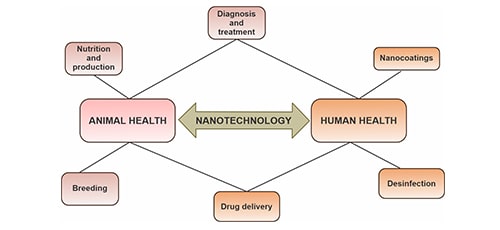
Citation of the article: Adv. Mater. Lett., 2020, 11(9), 20091552. [Download Full Text in PDF]
Article 3: Numerical and Analytical study on Axial Compression behaviour of Pultruded GFRP members
The third article emphasizes about the pultruded profiles, which are used as a new innovative material in civil engineering construction applications. This article is reported by Vinanti Kulkarni et al., from National Institute of Technology, India. Here author investigated the three different sizes of I-sections made of glass fibre and embedded in polyester matrix with pinned-pinned support condition are used. Here numerical analysis has been carried out using commercially available software package ANSYS and analytical behaviour is done by using EuroCode “JRC report EUR 27666 EN”. In the end, the results of numerical investigation are compared with analytical results and results are seems to be within range.
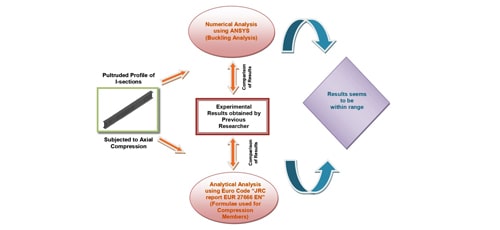
Citation of the article: Adv. Mater. Lett., 2020, 11(9), 20091553. [Download Full Text in PDF]
Article 4: Optical Characterization of Double Perovskite Ba2FeNbO6 Powders Derived from Molten Salt Method
The fourth article is reported by Yao Lu et al., from Nanjing University, China. Here authors discussed double perovskite Ba2FeNbO6 (BFN) powders, which were synthesized by molten salt method. The present work offers an effective approach to tuning the Eg of BFN powders, which find promising applications in the fields of photovoltaic and photocatalytic devices.
In this article, optical properties were characterized by UV-Vis absorption spectra, and the band gaps (Eg) were determined to be 2.12 - 2.25 eV. Here, the authors’ indicate that the overlapping between the O-2p and Fe-3d orbitals is changed, making the Eg values changed. A small absorption shoulder with absorption edge at 650 nm (Eg ~ 1.91 eV) observed in the BFN powders, was ascribed to the d-d electronic transition from the Fe 3d-b2g to Fe 3d-b1g orbitals, which were formed by further splitting of Fe 3d orbitals in the distorted octahedral field.
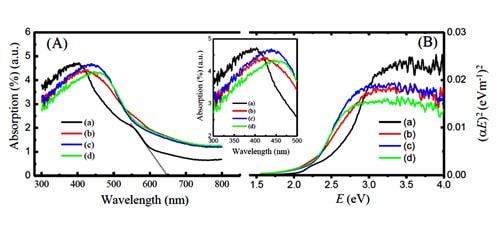
Citation of the article: Adv. Mater. Lett., 2020, 11(9), 20091554. [Download Full Text in PDF]
Article 5: Solar Cell Characteristic Studies on Metal Organic Framework/TiO2 Hybrid Solar Cell
The fifth article described about the electrochemical polymerization of TCA on copper electrode forms CuTCA metal-organic framework (MOF). The CuTCA acts as optically active and hole transport layer whereas TiO2 acts as exciton dissociation surface. This article is authored by K. Deepak et al, from Reva University and Nitte Meenakshi Institute of Technology of India. Here the device was characterized under 100 mW/cm2 condition in Cu/CuTCA-MOF/TiO2/Ag geometry, where copper and silver serve as bottom and top electrodes, respectively. The device yield power conversion efficiency (PCE) of 0.196 with open-circuit voltage (Voc), short circuit current (Isc) as 0.161 V and 0.431 mA/cm2 respectively.
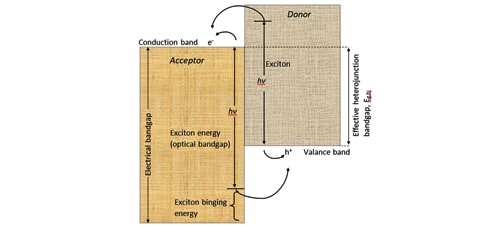
Citation of the article: Adv. Mater. Lett., 2020, 11(9), 20091555. [Download Full Text in PDF]
Article 6: In-situ Prepared 2D Covalent Organic Framework as a Photocatalyst in the Photocatalytic-Biocatalytic Attached System for Highly Selective L-Glutamate Production under Solar Light
The sixth article of the issue presents the details about covalent organic frameworks (COFs), which are a class of porous organic polymers with designable and predictable platform that may provide new opportunities to develop a metal-free in-situ prepared photocatalyst by condensation method. This article was authored by Pooja Singh et al., from Madan Mohan Malaviya University of Technology, Banaras Hindu University and Chandigarh University of the India. Here authors designed a new class of two dimensional covalent organic frameworks (2DCOFs), which is important for further growth in this promising field for boosting selective solar chemical productions under solar light. In this article, in-situ prepared photocatalyst has an excellent solar light-harvesting ability, band gap suitability, and highly organized π-electron channels are very applicable for highly selective solar chemical (L-glutamate) production and expected to trigger further interest in developing flexible films for solar energy transformation applications.
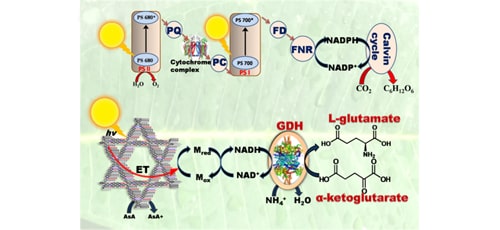
Citation of the article: Adv. Mater. Lett., 2020, 11(9), 20091556. [Download Full Text in PDF]
Article 7: Molecular Dynamics and FEM Modeling of Composites Having High Thermal Conductivity
The seventh article emphasizes more about the requirement of material that has high thermal conductivity as well as suitable electric insulating properties. Such materials are required for electronic components and solar panels. This article is authored by Sumit Sharma et al., from Dr. B R Ambedkar National Institute of Technology, India. In this study, the multi-scale modeling of epoxy (bisphenol-A) reinforced alumina composite has been performed using BIOVIA Materials Studio and Abaqus. Modeling has been done for varying volume fraction (Vf) of alumina. Heat transfer analysis has been done using Abaqus/Explicit. It was found that the thermal conductivity first increased till Vf = 20% and then decreased. When the concentration of alumina was increased further after Vf = 20%, the orientation of alumina particles changed from being in-plane to random, resulting in a fall in the values of thermal conductivity.
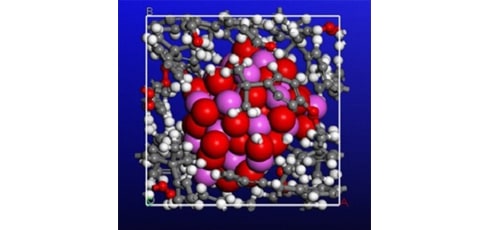
Citation of the article: Adv. Mater. Lett., 2020, 11(9), 20091557. [Download Full Text in PDF]
Article 8: Easy-Synthesis of BDA/ABDA Functionalized Hydrophilic Superparamagnetic Iron Oxide Nanoparticles for Magnetic-Hyperthermia Application
The eighth article reported an easy process for the synthesis of superparamagnetic iron oxide nanoparticles (SPIOs, with a size of ~ 10 nm), where these SPIOs are surface-functionalized with novel pi-electron rich surfactants such as 1,4-benzene dicarboxylic acid (BDA) and 2-amino-1,4-benzene dicarboxylic acid (ABDA). This article is authored by Ganeshlenin Kandasamy et al., from Vel Tech Rangarajan Dr. Sagunthala R&D Institute of Science and Technology, Shiv Nadar University, Institute Of Chemical Technology of Indian Oil Odisha Campus from India. In this study, the BDA/ABDA capped SPIOs have demonstrated well crystalline character, excellent colloidal stability, and high saturation magnetization. Thus, the as-prepared BDA/ABDA-SPIOs can be used as promising heating agents for magnetic-hyperthermia based biomedical applications.
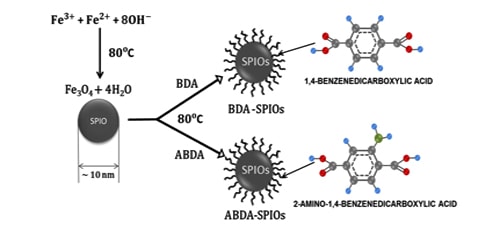
Citation of the article: Adv. Mater. Lett., 2020, 11(9), 20091558. [Download Full Text in PDF]
Article 9: Electrochemical and Photocatalytic Properties of Green Nickel Oxide Nanomaterial Synthesized using Plectranthus Amboinicus Plant Leaf Extract
The ninth article of the issue reported the successful synthesis of NiO nanomaterial by combustion method using Plectranthus amboinicus plant leaves extract. This article is authored by N.B. Arun Kumar et al., from Jamal Mohamed College, Davanagere University, East West Institute of Technology from the India and Adama Science and Technology University from Ethiopia. Here, the authors’ research explained that the diffraction pattern and image analysis confirmed the FCC lattice structure for green NiO nanomaterial (g-NONM) with spongy, agglomerated, and porous nature. The best part of the study was the fast reply (3 s) of the prepared electrode in sensing the drugs at 1 mM concentration solution. In addition, g-NONM can be easily fabricated into stable electrode material for supercapacitors applications. The results suggested that g-NONM can be an efficient and cheaper material for photocatalytic, sensor and supercapacitor applications.
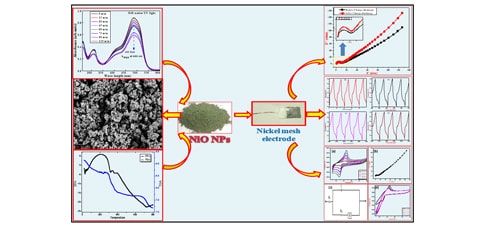
Citation of the article: Adv. Mater. Lett., 2020, 11(9), 20091559. [Download Full Text in PDF]
All original research articles which are published by Advanced Materials Letters have undergone peer reviewed; are immediately free to access and download from https://www.vbripress.com/aml/. International Association of Advanced Materials, IAAM invites all the members from materials community to promote this not-for-profit Diamond Open Access Publishing by submitting their articles or special issue proposal in the Advanced Materials Letters. All the articles published in the Advanced Materials Letters follow peer-review process by manuscript central, ScholarOne – Web of Science Group – Clarivate Analytics, USA. The researchers are invited to submit their manuscripts at journal’s ScholarOne Manuscript Submission System.
August 19th, 2020 IAAM Blog International Association of Advanced Materials Leave a Comment
Leave a Reply
Your email address will not be published. Required fields are marked *
Search
Recent Posts
- The 15th Anniversary of Advancing Materials
- Materials Triggered Towards Climate Neutral and Bio Active Functionality Via Nano and Electrochemical Interaction: Evolution of Advancement in the Volume 12 of Advanced Materials Letters, August 2021
- Promising Materials Features Transforming Sustainable Development with Intelligence and Green Chemistry: Exclusive Paradigm of the Volume 12 of Advanced Materials Letter, July 2021
- Attaining the SDGs Through Resilient Approach Needed High Performances Materials, Symbolize in the 6th Issue, Volume 12, June 2021 of Advanced Materials Letters